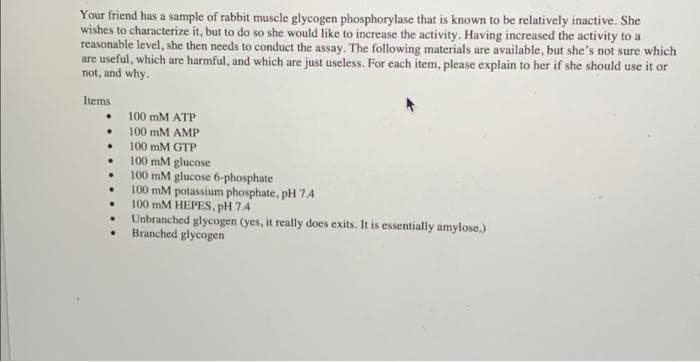Your friend has a sample of rabbit muscle glycogen phosphorylase that is known to be relatively inactive. She wishes to characterize it, but to do so she would like to increase the activity. Having increased the activity to a reasonable level, she then needs to conduct the assay. The following materials are available, but she's not sure which are useful, which are harmful, and which are just useless. For each item, please explain to her if she should use it or not, and why.
Your friend has a sample of rabbit muscle glycogen phosphorylase that is known to be relatively inactive. She wishes to characterize it, but to do so she would like to increase the activity. Having increased the activity to a reasonable level, she then needs to conduct the assay. The following materials are available, but she's not sure which are useful, which are harmful, and which are just useless. For each item, please explain to her if she should use it or not, and why.
Biochemistry
6th Edition
ISBN:9781305577206
Author:Reginald H. Garrett, Charles M. Grisham
Publisher:Reginald H. Garrett, Charles M. Grisham
Chapter26: Synthesis And Degradation Of Nucleotides
Section: Chapter Questions
Problem 10P
Related questions
Question
5

Transcribed Image Text:Your friend has a sample of rabbit muscle glycogen phosphorylase that is known to be relatively inactive. She
wishes to characterize it, but to do so she would like to increase the activity. Having increased the activity to a
reasonable level, she then needs to conduct the assay. The following materials are available, but she's not sure which
are useful, which are harmful, and which are just useless. For each item, please explain to her if she should use it or
not, and why.
Items
100 mM ATP
100 mM AMP
100 mM GTP
100 mM glucose
100 mM glucose 6-phosphate
100 mM potassium phosphate, pH 7.4
100 mM HEPES. pH 74
Unbranched glycogen (yes, it really does exits. It is essentially amylose.)
Branched glycogen
Expert Solution
This question has been solved!
Explore an expertly crafted, step-by-step solution for a thorough understanding of key concepts.
This is a popular solution!
Trending now
This is a popular solution!
Step by step
Solved in 2 steps

Recommended textbooks for you

Biochemistry
Biochemistry
ISBN:
9781305577206
Author:
Reginald H. Garrett, Charles M. Grisham
Publisher:
Cengage Learning

Biochemistry
Biochemistry
ISBN:
9781305577206
Author:
Reginald H. Garrett, Charles M. Grisham
Publisher:
Cengage Learning